
PHY stands for "Physical Layer," which forms the first and lowest layer in the OSI model. The physical layer handles the actual transmission and reception of raw data bits over media such as cables, fiber optics, or wireless signals. PHY converts digital data into electrical, optical, or radio signals, making basic device connectivity possible. Because PHY directly affects signal quality and network performance, understanding it is essential for anyone interested in networking and communication technologies.
In networking hardware design, the Ethernet PHY (Physical Layer Transceiver) is a critical component that bridges the digital world of MAC controllers and the physical cabling or fiber used for data transmission. This article explains what an Ethernet PHY is, outlines its key functions, explores how it interfaces with magnetics, and highlights how LINK‑PP RJ45 connectors support optimal PHY integration.
What Is an Ethernet PHY?
A PHY implements the OSI model’s physical layer, turning digital frames into analog signals that travel over twisted pair or optical media, and vice versa. It typically includes both the Physical Coding Sublayer (PCS) and the Physical Medium Dependent (PMD) interface for electrical or optical media.
On the digital end, the PHY connects to the MAC (Media Access Control) via standard interfaces such as MII, RMII, RGMII, or SGMII.

Core Functions of an Ethernet PHY
Signal Conversion (Digital ↔ Analog): Converts MAC‑layer bitstreams to electrical or optical signals suitable for transmission, and recovers digital data on reception.
Coding & Modulation: Handles encoding standards like MLT‑3 (100BASE‑TX), PAM‑5 (1000BASE‑T), or PAM‑16 (10GBASE‑T) depending on Ethernet generation.
Clock/Data Recovery: Synchronizes and recovers clock from the received signal’s transitions.
Auto‑Negotiation & Link Detection: Negotiates link speed (10/100/1000 Mbps or above) and duplex mode, and establishes or monitors link status.
Line Driver Output Mode: Manages whether the PHY uses current‑mode (current source differential output) or voltage‑mode (voltage swing output), influencing its compatibility with transformers and RF performance.
Note: PAM-16 is the modulation scheme used in the IEEE 802.3an standard for 10GBASE-T Ethernet. It requires complex Forward Error Correction (FEC) mechanisms to ensure signal integrity over twisted-pair cabling.
Current‑Mode vs Voltage‑Mode PHY
Voltage‑Mode PHY: Outputs fixed voltage swings (e.g. ±3.3V). Common in legacy 10/100 Mbps PHYs, but less robust for EMC and signal integrity in modern high‑speed applications.
Current‑Mode PHY: Emits constant differential currents (often ±8 mA), which produce voltage swings across transformer windings or load resistors. This is the industry standard for 1000BASE‑T and higher speeds because it ensures stable differential signalling, reduced EMI, and compatibility with magnetics-based designs.

How Does Ethernet PHY Interface with Magnetics and RJ45?
Ethernet PHY outputs must be coupled through magnetics (transformer and common-mode choke) to connect to an RJ45 jack. These components provide galvanic isolation, impedance matching (typically 100 Ω differential), and EMI suppression.
LINK‑PP’s integrated RJ45 magnetic connectors (MagJacks) embed these transformer networks directly into the jack housing, offering a pre‑matched solution that simplifies PCB layout and ensures PHY‑level compatibility.
Typical architecture:
MAC + SGMII/RGMII → PHY (current‑mode) → Integrated magnetics (MagJack) → RJ45 → Ethernet cableSelecting a PHY along with a LINK‑PP MagJack ensures optimal signal integrity, EMI performance, and compliance with IEEE 802.3 standards. Many LINK‑PP products (e.g. LPJG0926HENL, LPJG0933HENL) are tailored for Gigabit and multi‑gigabit PHYs and support PoE+ / 10/100/1000 Base-T applications.
Final Thoughts
An Ethernet PHY is a sophisticated transceiver module that enables reliable, standard‑compliant data transmission across physical media. By understanding the difference between current‑mode and voltage‑mode PHYs, engineers can choose compatible LINK‑PP RJ45 magnetic connectors and build Ethernet hardware that excels in both performance and EMI compliance.


